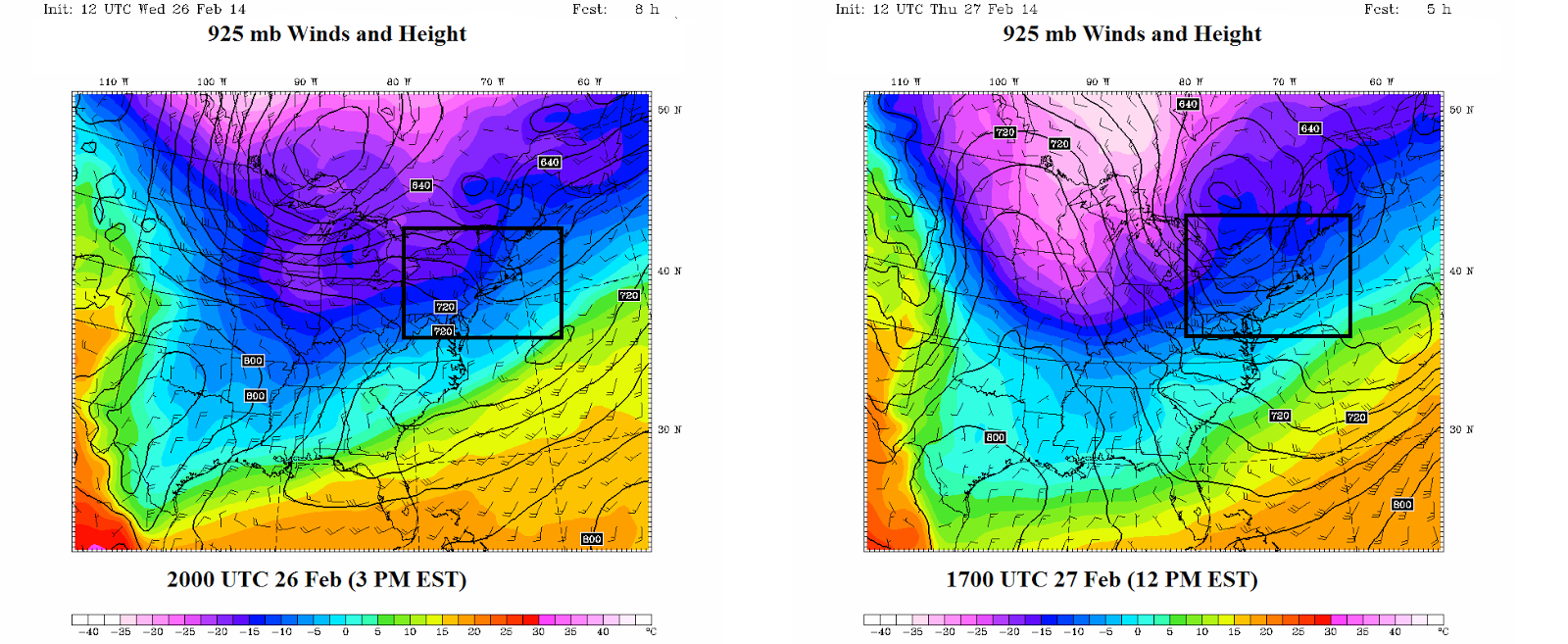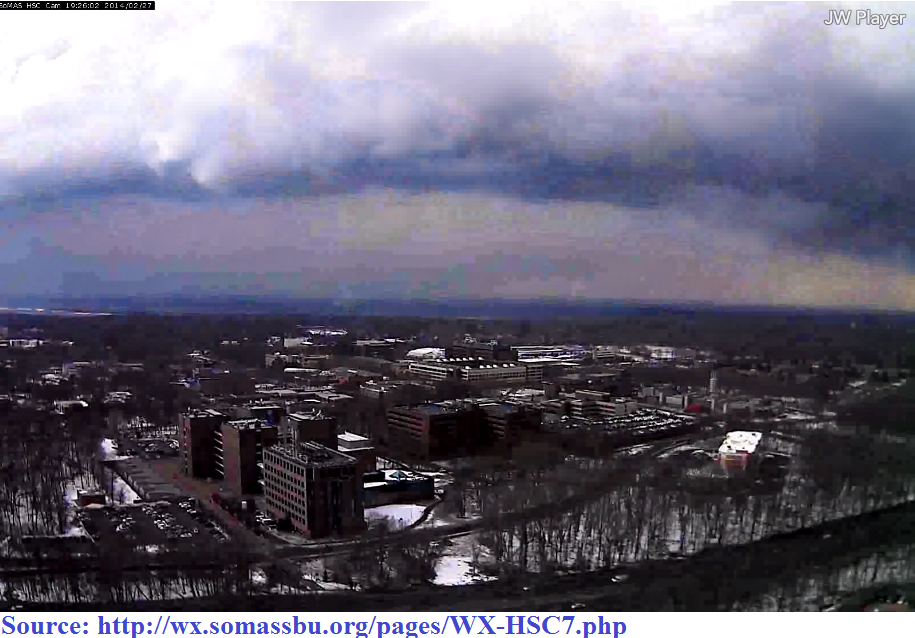You are late to leave your house and are hustling around to grab your bag and car keys and once you walk outside of your front door you see… it’s snowing?! Why is it snowing? They didn’t say it would snow. I don’t have any bread and milk! As similar thoughts run through your mind as you start your car and back out of your driveway, the sun comes out. Oh, that’s all? Wow, I give up on the weather. Don’t give up! There’s a great explanation for why for the past two days (Wednesday, February 26th and Thursday, February 27th) there have been lines or cells of snow showers flowing across our area.
These snow showers have been the result of the clashing of air masses in a smaller way than producing a large, coastal cyclone as has been discussed in previous posts on major snowbands. That’s why they are so transient, or move through quickly without too much accumulation or disruption of travel. However, they are capable of quickly dumping over an inch of snow and causing dangerously decreased visibility while driving. These snow showers can form as a result of surface forcing from cold air pushing warm air up and over it which condenses any water vapor into clouds which can precipitate. They can also form as a result of upper-level forcing which means that the air’s motion high up in the atmosphere can actually cause air at the surface to rise and any water vapor condenses into clouds which can precipitate. Most times, it’s a bit of both mechanisms.
So what was up with the snow showers on both February 26th and 27th? They were similar but also a little bit different, as I’ll explain.
A Tale of Two Days of Snow Showers
A very cold air mass has been creeping down into the Northeast from Canada and with it have been several fronts, or boundaries, of cold air making its advance towards our region. The image below shows a surface map for Wednesday, February 26th with a deep low pressure center north of the Great Lakes indicating that there’s cold air in place and a weaker low pressure center in Quebec north of New York with a cold front draped off the coast. The cold air behind this front and the fact that there was some help at upper-levels of the atmosphere acted to organize some lines of snow showers on this day.
 |
|
| NOAA/NWS Weather Prediction Center Surface Analysis and Radar for 2100Z 26 Feb (4 PM). |
Things were slightly different for Thursday, February 27th, however. That strong low pressure center and much colder air has made its way east and its the cold front associated with this that at 1 PM EST was analyzed to be stretching southward through Central New York and Pennsylvania that, combined with some favorable conditions at low-levels and upper-level forcing acted to organize some cells of snow showers across our area in the mid-afternoon.
 |
| NOAA/NWS Weather Prediction Center Surface Analysis and Radar for 1800Z 27 Feb (1 PM). |
The Wednesday, Feb. 26th snow showers were post-frontal when there was cold air advection (the wind blows colder air into the area) within the lower portion of the atmosphere. The Thursday, Feb. 27th snow showers were pre-frontal when there was warm air advection (the wind blows warmer air into the area) within the lower portion of the atmosphere. To look into this in more depth, the Stony Brook University-Weather Research and Forecasting (SBU-WRF) model was used to plot some variables which are operationally available to the public at the following website. The use of a weather model in a forecasting sense is also proof that these snow showers were predictable even though they were on such a small scale. The plots below show a slice of the atmosphere near the surface with temperatures shaded with the cooler colors indicating cold temperatures and the warmer colors indicating warm temperatures (can we go to Florida now, please?!) with Wednesday on the left and Thursday on the right. Notice first how much colder the air mass over the upper Great Plains has gotten over the course of a day. Notice second how within our box there is a transition, or gradient, between colder air and warmer air with colder air being to our northwest and warmer air to our southeast. It’s hard to tell but the winds within this box show the advection at this level, or the transport of air of a certain temperature into the region. On Wednesday, winds are mostly blowing from the northwest ushering in colder air. While on Thursday, winds are mostly blowing from the west-southwest which is actually ushering in a little bit of “warmer” air ahead of the air mass boundary.
 |
| Left: Wednesday, February 26th at 3 PM and Right: Thursday, February 27th at 12 PM showing 925 mb temperatures shaded and a box highlighting our region. |
This pattern of cold air and warm air advection can be seen be plotting a time series of temperature and wind direction at a location at the surface. Here’s the model forecast time series plots for Stony Brook University. When the winds are directed more from the north (indicated by the barbs that are pointing into the wind pointed more towards the northwest on the bottom plot) then there is colder air being brought to the station and the temperatures decrease. The reverse is true for when the winds blow more from the south or southwest which corresponds to warm air advection and the temperature increases.
The fact that the air mass can change at different levels of the atmosphere (low, middle and high) can help air rise or sink. For example, when there’s warm air advection in the lower part of the atmosphere, this may cause that air the be unstable and it will rise until it cools off to the average temperature of the rest of the air mass. Conversely, if there is cold air advection at mid-levels, air will want to sink until it will warm to the average temperature of the rest of the air mass. The result of the cold advection on Wednesday versus the warm advection on Thursday was that the snow showers were organized a bit differently across Long Island.
The following images show observed (left plot) and modeled (right plot) of radar reflectivity of the snow showers from the NWS/New York Radar.
 |
| Observed (left) and modeled (right) base radar reflectivity at 1700Z (12 PM EST). |
The above image is for the Wednesday snow showers which shows heavier precipitation to the southwest associated with the cold front but smaller banded snow showers with the same orientation as the cold front but much smaller and weaker. These are likely resulting from some forcing at upper levels of the atmosphere related to cold frontal structure.
 |
| Observed (left) and modeled (right) base radar reflectivity for 3 PM EST. |
The above image is for Thursday’s snow showers. Notice how there are scattered, cellular snow showers found just east of Long Island whereas there are more linear features found across Central New York (upper-left portion of box in the observed and upper-left of model area). The linear feature is associated with the surface-based cold front, however the warm air advection out ahead of it as previously discussed allowed there to be favorable conditions for sporadic rising air which combined with the forcing at upper-levels of the atmosphere led to some snow showers. The Health Sciences Center (HSC) at Stony Brook University as weather instrumentation complete with a camera which is useful in capturing events like this. Check out the image below for a snapshot from 3 PM EST Thursday.
 |
| Snapshot from HSC camera showing the back-end of some of the snow-producing clouds at 3 PM EST. |
So the moral of the story, or the tale of two days of snow showers, is that not every snowflake that is seen falling to the ground spells doom for Long Island. We are capable of getting weak snowfalls just as we are capable of getting crippling nor’easters, given the right air masses. While the mechanics behind these snow showers can be different and a little complicated, it’s nice to experience them because it’s similar to the type of precipitation structure we’d experience during the warmer seasons but loads cooler because there’s snow falling! Maybe it’s just that I’m super into snow, but I’d much rather get snowed on while walking unprepared to my car than get drenched by rain. Enjoy the snow while it lasts this winter season!




